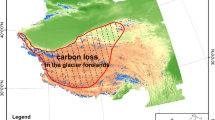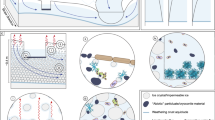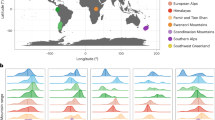Abstract
Biological processes on glacier surfaces affect glacier reflectance, influence surface energy budget and glacier response to climate warming, and determine glacier carbon exchange with the atmosphere. Currently, carbon balance of supraglacial environment is assessed as the balance between the activity of oxygenic phototrophs and the respiration rate of heterotrophic organisms. Here we present a metagenomic analysis of tiny wind-blown supraglacial sediment (cryoconite) from Baltoro (Pakistani Karakoram) and Forni (Italian Alps) glaciers, providing evidence for the occurrence in these environments of different and previously neglected metabolic pathways. Indeed, we observed high abundance of heterotrophic anoxygenic phototrophs, suggesting that light might directly supplement the energy demand of some bacterial strains allowing them to use as carbon source organic molecules, which otherwise would be respired. Furthermore, data suggest that CO2 could be produced also by microbiologically mediated oxidation of CO, which may be produced by photodegradation of organic matter.
Similar content being viewed by others
Log in or create a free account to read this content
Gain free access to this article, as well as selected content from this journal and more on nature.com
or
References
Bhatia MP, Das SB, Longnecker K, Charette MA, Kujawinski EB . (2010). Molecular characterization of dissolved organic matter associated with the Greenland ice sheet. Geochim Cosmochim Acta 74: 3768–3784.
Boetius A, Anesio AM, Deming JW, Mikucki JA, Rapp JZ . (2015). Microbial ecology of the cryosphere: sea ice and glacial habitats. Nat Rev Microbiol 13: 677–690.
Caliz J, Casamayor EO . (2014). Environmental controls and composition of anoxygenic photoheterotrophs in ultraoligotrophic high-altitude lakes (Central Pyrenees). Environ Microbiol Rep 6: 145–151.
Čuperová Z, Holzer E, Salka I, Sommaruga R, Koblízek M . (2013). Temporal changes and altitudinal distribution of aerobic anoxygenic phototrophs in mountain lakes. Appl Environ Microbiol 79: 6439–6446.
Darcy JL, Lynch RC, King AJ, Robeson MS, Schmidt SK . (2011). Global distribution of Polaromonas phylotypes — evidence for a highly successful dispersal capacity. PLoS One 6: e23742.
Edwards A, Mur LAJ, Girdwood SE, Anesio AM, Stibal M, Rassner SME et al. (2014). Coupled cryoconite ecosystem structure-function relationships are revealed by comparing bacterial communities in alpine and Arctic glaciers. FEMS Microbiol Ecol 89: 222–237.
Edwards A, Pachebat JA, Swain M, Hegarty M, Hodson AJ, Irvine-Fynn TDL et al. (2013). A metagenomic snapshot of taxonomic and functional diversity in an alpine glacier cryoconite ecosystem. Environ Res Lett 8: 035003.
Franzetti A, Tatangelo V, Gandolfi I, Bertolini V, Bestetti G, Diolaiuti G et al. (2013). Bacterial community structure on two alpine debris-covered glaciers and biogeography of Polaromonas phylotypes. ISME J 7: 1483–1492.
Friedrich CG, Bardischewsky F, Rother D, Quentmeier A, Fischer J . (2005). Prokaryotic sulfur oxidation. Curr Opin Microbiol 8: 253–259.
Haan D, Zuo Y, Gros V, Brenninkmeijer CAM . (2001). Photochemical production of carbon monoxide in snow. J Atmos Chem 40: 217–230.
Hood E, Battin TJ, Fellman J, O’Neel S, Spencer RGM . (2015). Storage and release of organic carbon from glaciers and ice sheets. Nat Geosci 8: 91–96.
IPPC - Intergovernmental Panel on Climate Change.. (2014) Climate Change 2013 – The Physical Science Basis: Working Group I Contribution to the Fifth Assessment Report of the Intergovernmental Panel on Climate Change. Cambridge University Press: Cambridge, UK.
King GM, Weber CF . (2007). Distribution, diversity and ecology of aerobic CO-oxidizing bacteria. Nat Rev Microbiol 5: 107–118.
Legrand M, Preunkert S, Jourdain B, Guilhermet J, Faïn X, Alekhina I et al. (2013). Water-soluble organic carbon in snow and ice deposited at Alpine, Greenland, and Antarctic sites: a critical review of available data and their atmospheric relevance. Clim Past 9: 2195–2211.
Mattes TE, Alexander AK, Richardson PM, Munk AC, Han CS, Stothard P et al. (2008). The genome of Polaromonas sp strain JS666: Insights into the evolution of a hydrocarbon- and xenobiotic-degrading bacterium, and features of relevance to biotechnology. Appl Environ Microbiol 74: 6405–6416.
Michaud L, Caruso C, Mangano S, Interdonato F, Bruni V, Lo Giudice A . (2012). Predominance of Flavobacterium, Pseudomonas, and Polaromonas within the prokaryotic community of freshwater shallow lakes in the northern Victoria Land, East Antarctica. FEMS Microbiol Ecol 82: 391–404.
Segawa T, Ishii S, Ohte N, Akiyoshi A, Yamada A, Maruyama F et al. (2014). The nitrogen cycle in cryoconites: naturally occurring nitrification-denitrification granules on a glacier. Environ Microbiol 16: 3250–3262.
Stibal M, Šabacká M, Žárský J . (2012). Biological processes on glacier and ice sheet surfaces. Nat Geosci 5: 771–774.
Stibal M, Schostag M, Cameron KA, Hansen LH, Chandler DM, Wadham JL et al. (2014). Different bulk and active bacterial communities in cryoconite from the margin and interior of the Greenland ice sheet. Environ Microbiol Rep 7: 293–300.
Varin T, Lovejoy C, Jungblut AD, Vincent WF, Corbeil J, Edwards A et al. (2013). Metagenomic analysis of stress genes in microbial mat communities from Antarctica and the High Arctic. Appl Environ Microbiol 78: 035003.
Xie H, Zafiriou OC . (2009). Evidence for significant photochemical production of carbon monoxide by particles in coastal and oligotrophic marine waters. Geophys Res Lett 36: L23606.
Yurkov V, Hughes E . (2013). Genes associated with the peculiar phenotypes of the aerobic anoxygenic phototrophs. Adv Bot Res 66: 327–358.
Acknowledgements
We thank Parco Tecnologico Padano (Lodi, Italy) for technical assistance and sequencing. We also thank Ev-K2-CNR association for support and logistics during expedition on Baltoro Glacier. This work was partially funded by the Italian Ministry of Research (PRIN grant 2010AYKTAB to CS) and by University of Milano-Bicocca (grant 7-19-2001100-2 to RA). Bioinformatics analyses have been run on PICO server (CINECA, Bologna, Italy; project MEGABIT—grant ID: HP10CLG7F to AF).
Data Accessibility
Sequence data of metagenomes were submitted to European Nucleotide Archive (ENA), study accession number PRJEB12327 (http://www.ebi.ac.uk/ena/data/view/PRJEB12327).
Author information
Authors and Affiliations
Corresponding author
Ethics declarations
Competing interests
The authors declare no conflict of interest.
Additional information
Supplementary Information accompanies this paper on The ISME Journal website
Supplementary information
Rights and permissions
About this article
Cite this article
Franzetti, A., Tagliaferri, I., Gandolfi, I. et al. Light-dependent microbial metabolisms drive carbon fluxes on glacier surfaces. ISME J 10, 2984–2988 (2016). https://doi.org/10.1038/ismej.2016.72
Received:
Revised:
Accepted:
Published:
Issue date:
DOI: https://doi.org/10.1038/ismej.2016.72
This article is cited by
-
Is Oxygenation Related to the Decomposition of Organic Matter in Cryoconite Holes?
Ecosystems (2022)
-
Microbial ecology of the cryosphere (glacial and permafrost habitats): current knowledge
Applied Microbiology and Biotechnology (2019)
-
Water bears dominated cryoconite hole ecosystems: densities, habitat preferences and physiological adaptations of Tardigrada on an alpine glacier
Aquatic Ecology (2019)
-
Fine-scale spatial heterogeneity of invertebrates within cryoconite holes
Aquatic Ecology (2019)
-
Cryoconite as a temporary sink for anthropogenic species stored in glaciers
Scientific Reports (2017)



